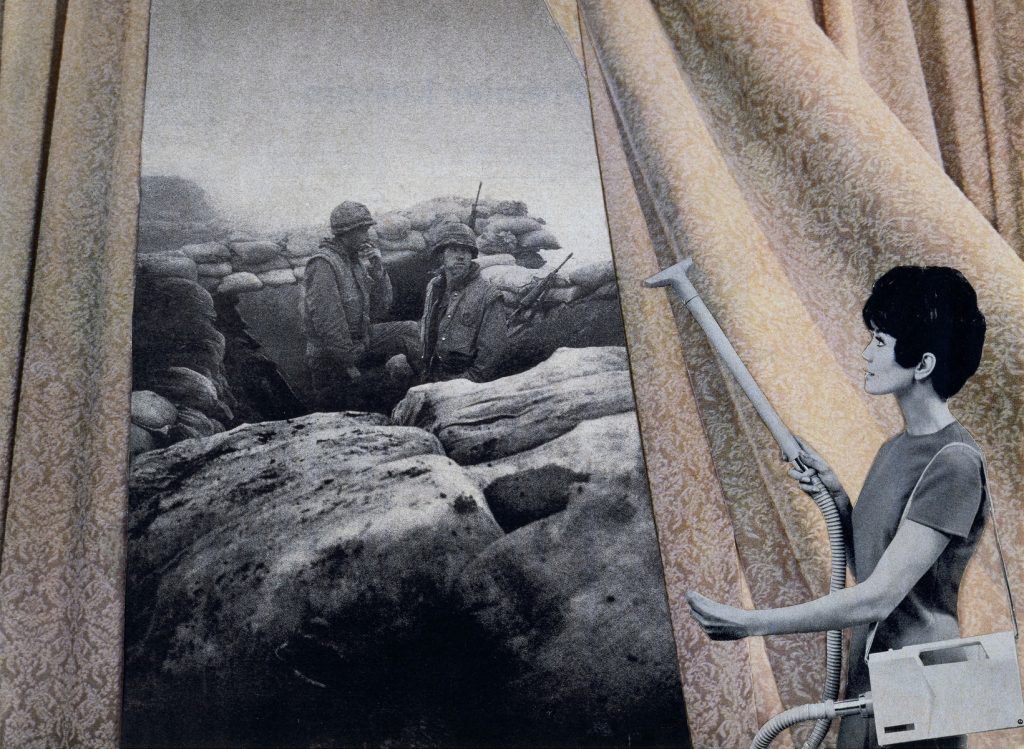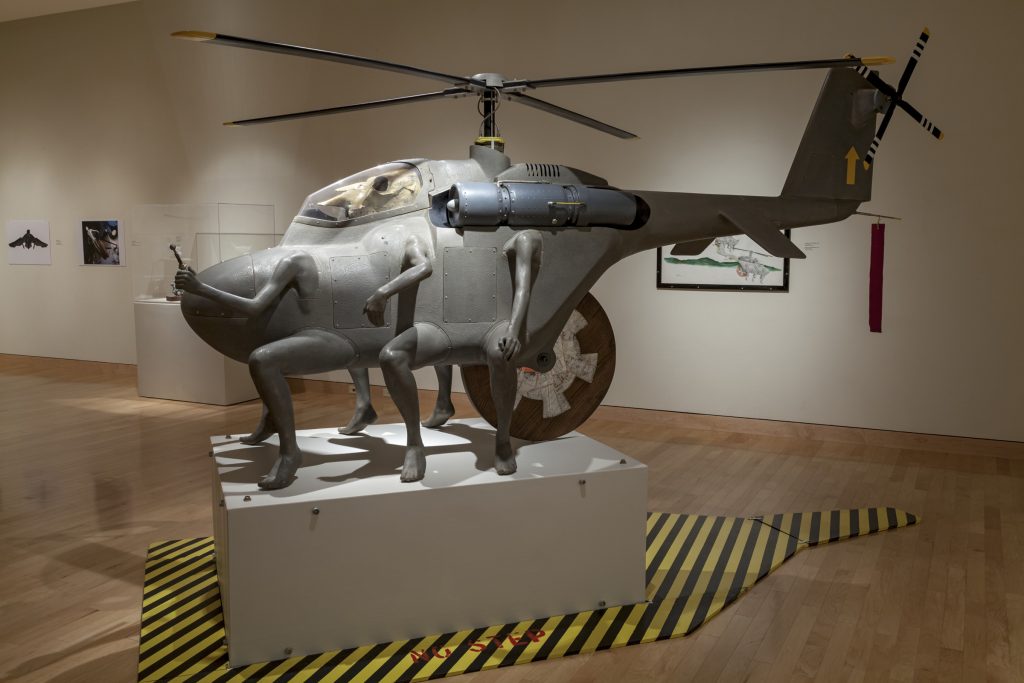In: Vietnam

Martha Rosler | House Beautiful: Bringing the War Home, 1967–1972
March 24, 2023Martha Rosler | House Beautiful: Bringing the War Home, 1967–1972
Cotton’s generation grew up with a war in the house. For them, games of cops and robbers and cowboys and Indians no longer satisfied the senses. A boy had but to turn a control to be totally involved in the violent distension of experience that was Vietnam on television. Cotton became addicted to it. Vietnam was even a portable war.
A boy had but to move his personal set to have air strikes in the living room, search-and-destroy operations in the bedroom, naval bombardment in the bathroom—napalm before school, body bags before dinner.
(Glendon Swarthout, Bless the Beasts and the Children)
I recently read The Sacred Lies of Minnow Bly by Stephanie Oakes. The premise – of a young woman who survives a doomsday cult – sent me down a rabbit hole, if you will, of research on these cults, and since then I’ve been devouring a number of texts on the topic.
One of these – Jeffrey Melnick, Charles Manson’s Creepy Crawl: The Many Lives of America’s Most Infamous Family – offers an interesting supposition. Melnick argues that the Tate – LaBianca murders were used by many on the right – Nixon, for example – as a means by which to shutter debate about the (even then) failure of the nuclear family in the United States. This is similar to Zizek’s comment that most conversations about socialism always have a chicken little proclaiming it ‘will end in the gulag!’. Other societal issues are cast in a different light from the Manson murders, as well (for example, Melnick talks about the dismissive attitude towards runaways – especially girls – at that time, criminalizing or infantilizing them, using several of the Manson ‘family’ as examples, instead of focusing on larger issues within society).
Melnick dismisses with derision the idea that Manson ‘ended’ the supposed utopic dream of the 1960s – and for this post, a point he makes stays with me. Bluntly, that the violence of the Manson family was nary a drop in the bucket to the televised, sanctioned and officially endorsed violence of the war in Vietnam and other societal pressures. His words: “If the countercultural fabric got torn it was not because a few celebrities were killed in August of 1969. We would be better off attending to the plight of returning veterans, the not unconnected influx of harder drugs into American cities, the ongoing runaway crisis, and a major effort by the dominant culture—from the president on down—to repudiate and abandon young people and their culture.”
And this brings us to Martha Rosler’s series House Beautiful: Bringing the War Home, 1967–72.
The initial incarnation of this series was about Vietnam: in a despairing commentary about history Rosler would revisit and reinterpret it decades later, for the ‘war against terror’ in Iraq and Afghanistan…..
Rosler – in the tradition of artists like Hannah Höch – employs collage, using images that are familiar to us in tandem with others that fracture and trouble the original ‘homes’ on display. These might ‘homes’ in the literal sense, but also the ideologies and assumptions that inform those spaces, sometimes so implicitly that to highlight them engenders a denial of them, like a fish unaware of water as it’s so ubiquitous.
‘This work is one of twenty pieces from Rosler’s House Beautiful: Bringing the War Home (c.1967-72) series created during, and influenced by, the Vietnam War. It was the first war in history that was literally brought into the homes of American people through the revolutionary new television set from which its horrors could be witnessed daily. It was often described as a “living room war” – a description loaded with strange poignancy as it shined a light on the eeriness of a nation living their everyday lives, ripe with consumerist concerns like keeping the stylish home drapes clean, all the while gruesome political realities took place elsewhere, becoming just another form of nightly entertainment in front of the tube.
Simultaneously, there is a feminist element to the work as it comments on the robotic mundaneness of female domestic work in the midst of global unrest. The idea of women striving to keep the house beautiful while war’s tragedies are omnipresent becomes almost comical, and presents a surreal picture about what we deem important. Recognizing the potential for manipulation in the photographic medium, Rosler once stated, “Any familiarity with photographic history shows that manipulation is integral to photography.”’ (from here)
More of Rosler’s extensive practice – and her roles as social critic and historian for more than half a century – can be seen here.
~ Bart Gazzola
Read More
Don Bonham | Twentieth Century Technology Utilized by Third World Mentality, 1993
September 9, 2022Don Bonham | Twentieth Century Technology Utilized by Third World Mentality, 1993
Don Bonham (1940 – 2014) was a sculptor who produced monumental works that intersect with classical ideas about art and also incorporated contemporary references – especially as pertains to industry and technology. His work alternates between humour and a disturbing – yet attractive – aesthetic that reflects back on a larger society, especially in terms of how often any new technological advance is met with the brutal inquiry of whether “Can this make killing less of a hassle?” (Sadly, the second blunt question is, “Can I have sex with it?”). If you think I’m wrong, consider other works by Bonham that would please J.G. Ballard as three dimensional iterations of some of Phoebe Gloeckner‘s illustrations to his texts…or horrify him, edit as you will.
Don’t criticize Bonham’s presumed priapism and the implicit male gaze in his work: an era gets the artwork it merits. His industrial works often openly acknowledged and built upon the fetishization of object that was a continuation of a fetishization of the female body. His works are always seductive and well executed, if initially unsettling.
In his own words: “The gap between human and machine is constantly shrinking. Are we to become more like machines, or machines more like us? The creators of technology have imbued machines with human characteristics, and this tendency is creating a more hospitable environment for their acceptance by society. As an artist I am only enlarging upon this concept.”
Years ago, a fine film critic spoke of how futurism, in cinema, was either a clean, antiseptic space, like an Apple store, or more like Blade Runner, and broken, dirty and more part of an industrial gothic aesthetic. Bonham falls within the latter.
I have been accused of being somewhat ‘subjective’ as a reviewer, often relying upon ‘inappropriate’ sources and considerations when engaging with artwork. This bemuses me, and entertains me even more when I consider that a motivation for featuring a work by Bonham is the rather disrespectful – though typical of the vagaries of institutions that claim to protect and nurture culture – decision by McIntosh Gallery, at the University of Western, to de accession one of his works from their collection. Curator, writer and gallerist Terry Graff has been working against that, and you can see his efforts – and learn more about Bonham and his legacy – at Graff’s social media.
But in looking at Bonham’s sculpture here (and many of his similar works that meld, merge and mash up humanity and machine, with a sense of militarism that is almost inappropriately amusing and intersects with black humour) a Vietnam era anti – war anthem from the 1960s comes to mind. This is fitting, as Bonham came to Canada during the period when many men from the United States were fleeing their country, opposed to the war there. However, “Bonham enlisted in the U.S. Marine Corps and served in an elite Recon unit in Southeast Asia. After six and a half years, he was honorably discharged to enter the University of Oklahoma as an Art History Major. He left university before graduating and worked in Detroit on a Ford assembly line before moving, in 1968, to London, Ontario, where he discovered a dynamic arts community that reinforced his decision to pursue a career as a visual artist.” (from a retrospective of Bonham’s artwork at The Beaverbrook Art Gallery)
The song Sky Pilot by The Animals is as confrontational as Bonham’s Twentieth Century Technology Utilized by Third World Mentality, and for its time was surely controversial: and it’s necessary to include the print below that Bonham produced, of his modified – or realized – helicopters swooping down, mimicking that infamous scene where the ‘righteous’ decimate a village from Francis Ford Coppola’s Apocalypse Now. Death rides a pale horse, a mechanized cyborg that’s surely a descendant of Albert Pinkham Ryder’s The Race Track (Death on a Pale Horse), coming down from the sky….
Regionalism has both defined – and deformed – Canadian art and Canadian art history (and is arguably why Bonham’s work is being so disrespected by the University of Western. Graff is more erudite and informed on this front than I). But regionalism is also the lens through which I respond to the terms of ‘First World’ or ‘Third World’ (cited in the title of this work) which seem as archaic at times as ‘Cold War’ (an epoch I had to explain to students, when I used to teach at a university, and let’s remember that the ‘Second World’ was the Communist Bloc, and the most avowed communist country now is definitely ‘open for business’…).
Bluntly, there are those who have and those who have not, and the tools at hand are used to enhance the former and demean the latter: it is the ‘order of things’, in the era of late capitalist modernism (to quote Jameson) or, as I like to call it, late modernist capitalism. Trinh T. Minh-ha (a Vietnamese – so she has an intimate understanding of the construction of history, as pertains to colonization / imperialism – filmmaker, writer, literary theorist, composer, and professor) famously wrote that “there is a third world in every first world, and vice-versa.” Bonham – and myself, initially – spoke of Vietnam. But you’re more likely to see a third world in your own city, overseen and monitored by a machine not unlike this sculpture (with the excessive militarization of police departments), in the skies over Detroit or Cleveland or Baltimore…or my own site of Niagara, or my previous space of Saskatoon, with tent cities and other ‘undesirables’, too often given harm over help, unlike other more harmful groups that squat, rife with sedition and fascist symbols….
Many thanks to Terry Graff for support, and conversations, that helped define this essay. Much more about Bonham’s life and artwork can be seen at Graff’s social media feed (there is also a petition to make Western reverse their decision here) and Bonham was a past Artist You Need To Know, in AIH Studios’ ongoing series. That can be enjoyed here.
~ Bart Gazzola
Read More
Recent Comments